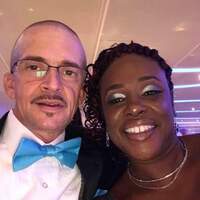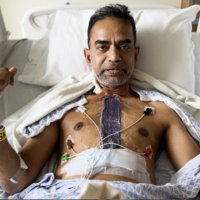Achieving Patient Priorities Through Robotic Innovation with Dr. T. Sloane Guy
Written By: Andrea Wickstrom, BSN, RN, PHN
Medical Expert: T. Sloane Guy, MD, Director of Robotic Cardiac Surgery at Georgia Heart Institute
Reviewed By: Adam Pick, Patient Advocate
Published: August 15, 2023
When facing treatment for mitral valve regurgitation, patients often wonder what safe-and-effective options exist to correct the valvular issue, address their symptoms, and restore normal life expectancy. While mitral valve therapy used to require open-heart surgery, there are minimally-invasive techniques that offer similar success rates and patient advantages when compared to traditional approaches through the sternum.
One minimally-invasive technique uses a “robot-assisted” surgical approach. To learn how new robotic innovations are helping patients, we met with Dr. T. Sloane Guy at the Mitral Conclave in New York City. Doctor Guy, Director of Robotic Cardiac Surgery at Georgia Heart Institute in Gainesville, Georgia, has successfully treated many patients in our community.
Key Learnings About Robotic Technology Advances
Here are key insights about robotic cardiac surgery shared by Dr. Guy during the interview:
- Safety is, and should be, the number one consideration for patients needing heart valve surgery. While Dr. Guy is committed to advancing technology for minimally-invasive robotic mitral valve surgery, his number one priority is patient safety. “Our number one priority is to get the patients safely through whatever operation we’re doing,” states Dr. Guy. “Our second priority is to give them an effective, durable operation that will fix their mitral valve. And last, our third priority is to do it in the least invasive way possible to allow that patient to recover more quickly and return to the life they want to lead.
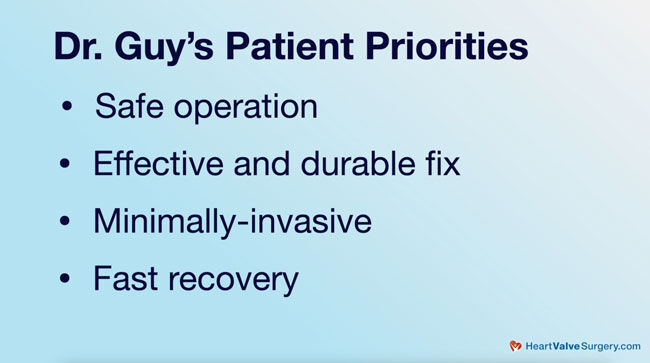
- Shortening the patient’s recovery period and decreasing post-operative pain drives Dr. Guy’s passion and innovative thinking for advancing minimally-invasive techniques using the robot.
- “Our latest advance is to do the surgery in the least invasive way done on earth,” states Dr. Guy. To perform a robotic mitral valve repair, Dr. Guy uses five small incisions, about the diameter of a pencil, near the right armpit to access the heart and place robotic tools and visual equipment. Dr. Guy continued, “When we do a mitral valve repair at the Georgia Heart Institute, the biggest incision of the body is 8 mm. I think this really makes a big difference in terms of the recovery period.”
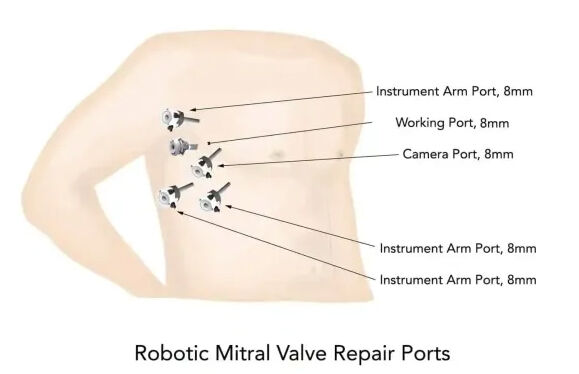
- Percutaneous cannulation is a new innovation Dr. Guy uses to connect the patient to the heart-lung machine using small catheters and ultrasound.
- Cryotherapy is another patient-centric innovation used by Dr. Guy to numb the port wounds for about twelve weeks after surgery. This pain control method allows hospitals to discharge up to 75% of patients within approximately three days, according to Dr. Guy. To learn more about cryoanalgesia, click here.
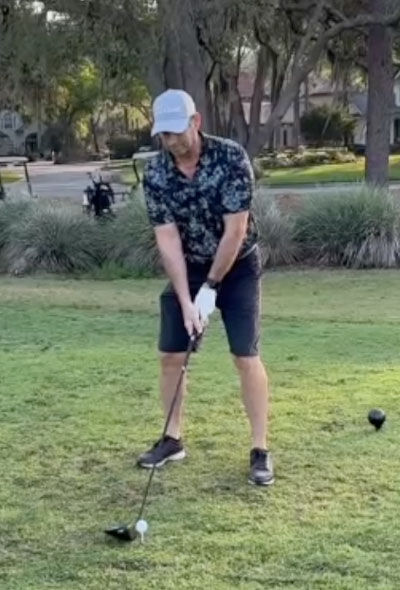 Patient of Dr. Guy’s Playing Golf Five Days
Patient of Dr. Guy’s Playing Golf Five Days
After Robotic Mitral Valve Repair
- Low-risk patients with uneventful operations may have a one or two-day hospital stay with an approximate one-week recovery period at home. Dr. Guy dreams of and is confident in taking robotic mitral valve repair even a step further by reducing the number of incisions, thereby causing less pain, and ultimately making recovery periods even shorter. During our interview, Dr. Guy shared the story of a mitral valve repair patient who played golf five days after surgery.
Thanks Dr. Guy and Georgia Heart Institute!
On behalf of our patient community, many thanks to Dr. T. Sloane Guy for sharing his passion and commitment to advancing the technology and the innovation for minimally-invasive mitral valve surgery. Also, many thanks to Georgia Heart Institute at Northeast Georgia Health System for taking such great care of heart valve patients!
Keep on tickin!
Adam
Video Transcript:
Adam Pick: Hi, everybody. It’s Adam with heartvalvesurgery.com, and we are at the Mitral Conclave in New York City. I’m thrilled to be joined by Dr. Sloane Guy who is the Director of Robotic Cardiac Surgery at Georgia Heart Institute in Gainesville, Georgia. Dr. Guy, great to see you again.
Dr. Guy: Great to see you, Adam.
Adam Pick: Thanks for being with me.
Dr. Guy: Absolutely.
Adam Pick: Yeah, Dr. Guy, you and I have known each other for many, many, many years.
Dr. Guy: Yeah.
Adam Pick: The one thing I know about you is your commitment to using technology to help patients with mitral valve disease. I got to ask you. What’s the latest innovation or technology advance that you’re using to help patients with mitral valve disease?
Dr. Guy: Sure, Adam, when I look at how we help patients, I look at the priorities, and I think our number one priority is get the patients safely through whatever operation we’re doing. Our second priority is to give them an effective durable operation that will fix their mitral valve, and the last, our third priority is to do it in the least invasive way possible to allow that patient to recover more quickly and return to the life that they want to lead. A lot of surgeons traditionally have not put a great deal of priority on recovery period, but as we’ve entered this era where what the patient wants is important, I think that becomes a priority. My life’s work and really obsession has been to make mitral valve surgery less and less invasive, and the robotic system is what has allowed me to do that.
Currently, our latest advance is to do the surgery in, really, the least invasive way done on earth, which currently involves five pencil size ports in the right armpit area, all percutaneous cannulation, which can be hard for patients to understand, but essentially, what it means is, instead of making incision of our arteries and veins in the leg to go on the heart/lung machine, we use ultrasound and small needles and wires and a thoracoscopy to safely place catheters with just tiny stab wounds. When we do a mitral valve repair at the Georgia Heart Institute, the biggest incision of the body is 8 mm. I think this really makes a big difference in terms of recovery period. The other thing that we do is that we use cryotherapy where we put these ports, which makes the area where the incisions go numb for about 12 weeks, and so we are able to discharge patients, I’d say about 75% of our patient, within three days…
Adam Pick: Wow!
Dr. Gay: …and a good proportion within two days and not as insignificant number of patients are going home the day after. For instance, I did a patient this week. We did a very complex robotic endoscopic mitral valve repair, and that patient went home the day after heart surgery. This would be unthinkable in the past. Now, that’s not every single patient, but for low-risk patients that have a smooth operation, a one- or two-day stay in the hospital and maybe a one-week recovery to nearly full functionality is not uncommon for us.
I want to go even further than that. I want to have even fewer incisions eventually, even less pain, and even quicker recovery. My dream would be to have eventually same day mitral valve repair surgery, and I’m absolutely convinced that I can achieve that.
Adam Pick: This is fascinating given your passion. I think on social media I’ve seen a post where you had a patient doing some activity just a few days after surgery. Can you explain what you posted…
Dr. Gay: Sure.
Adam Pick: …what the result was?
Dr. Gay: This gentleman came to us with a complex mitral valve problem, prolapse and regurgitation. We took him in the operating room and did just exactly as I described. We used the five 8 mm ports, the cryotherapy for pain reduction, all percutaneous cannulation, no open incisions at all. This patient was discharged from the hospital the afternoon after following his surgery. He got surgery one day, discharged the next day, and I asked him to stick around in the area. He was from Florida, but he decided to fly back I think on Day 3 after surgery to Florida.
He called me and said that he had just walked two miles on Day 3, and he got a little short of breath. Was that okay? I told him, look, most patients after heart surgery are still in the ICU or [05:07] at that point in time, and that was remarkable and not to worry about it. On Day 5, he went and played nine holes of golf. It’s a video of him swinging a golf club.
Now, that’s not every patient, but it shows you what’s possible where traditionally we had patients in the hospital for a week or more after heart surgery, and I think this really matters. When we talk to other surgeons who don’t put an emphasis on minimally invasive, their general argument is that what difference does it make at five years if the results are good in both cases, a maximally invasive sternal splitting operation or an endoscopic operation?
While that is true, there’s value in that, I think that they neglect to see the value to the patient and family of a speedy recovery, being able to get back to work, lack of pain. I mean, folks just don’t like lengthy recovery periods after surgery if it can be avoided. Now, not everyone can have that, but for uncomplicated mitral valve repairs, it should be possible to get most of the patients home within one to three days.
Adam Pick: Dr. Guy, on behalf of all your patients in the past, current, and in the future, I can’t thank you enough for taking the time to commit yourself to enhancing not just their hearts but their lives, and so on behalf of all the patients at HeartValveSurgery.com, patients all over the world, I just want to thank you and your team there at Georgia Heart Institute.
Dr. Guy: Thank you, Adam, for your advocacy of the patients. I think it really makes a big difference.


